13 Types Of RED BIRDS In Arizona (ID Guide With Photos)
Did you recently come across a red bird in Arizona, and want to know what species it was?
Identifying red-colored birds in Arizona is not as easy as it might seem, since there are many bird species in the Grand Canyon State that are either completely red or partially red.
To help you identify the bird you saw, we’ll cover all the different red birds of Arizona.
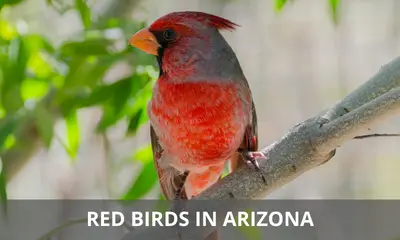
What red birds are found in Arizona?
The 13 types of red birds found in Arizona are:
- Northern Cardinal
- House Finch
- Summer Tanager
- Vermilion Flycatcher
- Pyrrhuloxia
- Hepatic Tanager
- Western Tanager
- Cassin’s Finch
- Painted Redstart
- Painted Bunting
- Purple Finch
- Pine Grosbeak
- Red Crossbill
Two of these Arizona birds are entirely red (the Northern Cardinal and Summer Tanager), while the others are partially red (more on that below).
Now let’s dive into the details, and take a closer look at each of these birds in order to get the full scoop:
Northern Cardinal
Scientific name: Cardinalis cardinalis
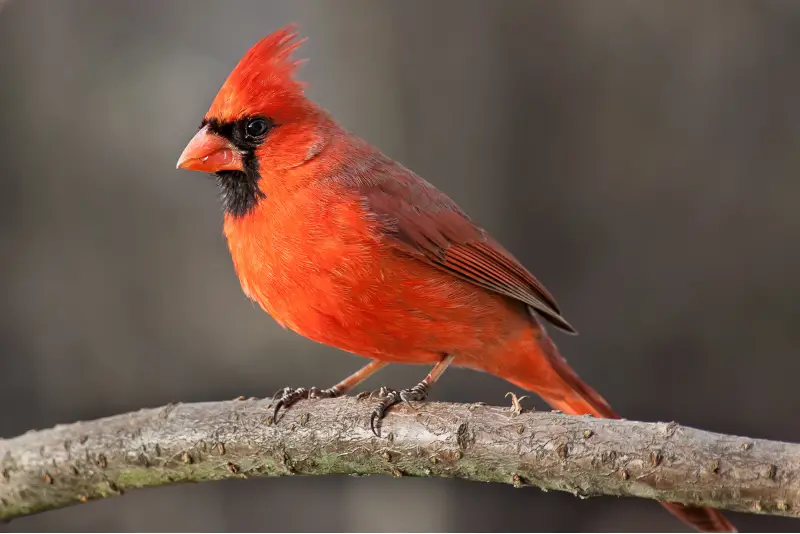
The Northern Cardinal is one of the most well known red birds found in Arizona.
Male Northern Cardinals have a bright crimson red color almost all over, with a slightly darker red on their back and wing feathers.
In addition, the face has a black mask extending from the bright red bill to the throat.
Female Northern Cardinals are not quite as colorful as males, and have a more buff-brown body color with some reddish tinges, although they also have a bright red bill.
The Northern Cardinal is a common bird in Arizona, and can be seen year round in backyards, small forests, and parks.
During the winter months it doesn’t defend its territory, and sometimes gathers in flocks of up to 25 individuals that feed together. This bird is a regular visitor at bird feeders.
House Finch
Scientific name: Haemorhous mexicanus
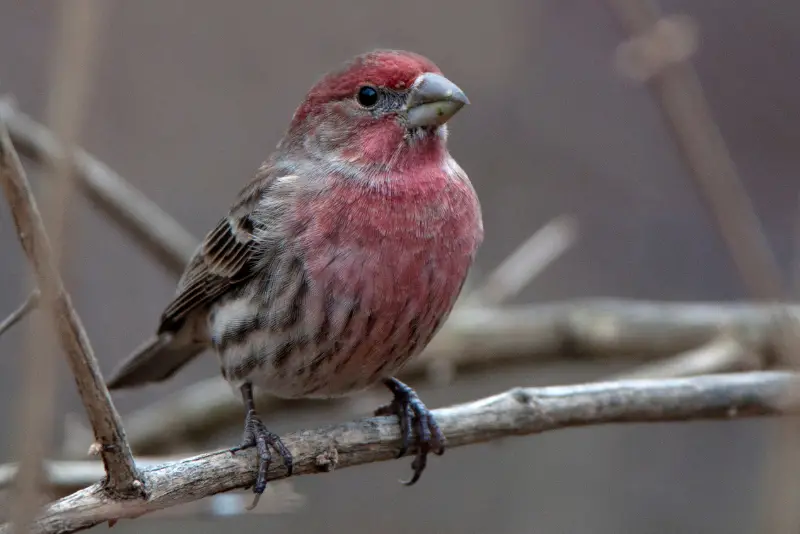
The House Finch is a common red bird in Arizona, and is mostly found in settled areas, ranging from small towns to large metropolitan centers.
Adult male House Finches can be identified by the bright red feathers on the head and upper breast, although in some cases they are slightly more orange or yellowish in color.
The females lack any red coloration, and instead have grayish streaks on a brown background.
The House Finch was originally a western bird, and it wasn’t until the 1940s that this bird was discovered in New York and other places on the east coast of the US.
These finches are the most common red birds found in Arizona
The eastern House Finch population began to grow in the 1950s and 60s, and by the year 2000, it had expanded so far west that it connected with the original western population.
The House Finch is entirely herbivorous, and feeds on seeds, buds, and fruits.
If you set up a bird feeder in your backyard, you can expect House Finches to be among the first birds to visit it.
The House Finch is found in Arizona all year round, and while it is not a migratory bird, it does move to areas with more food outside of the breeding season.
Summer Tanager
Scientific name: Piranga rubra
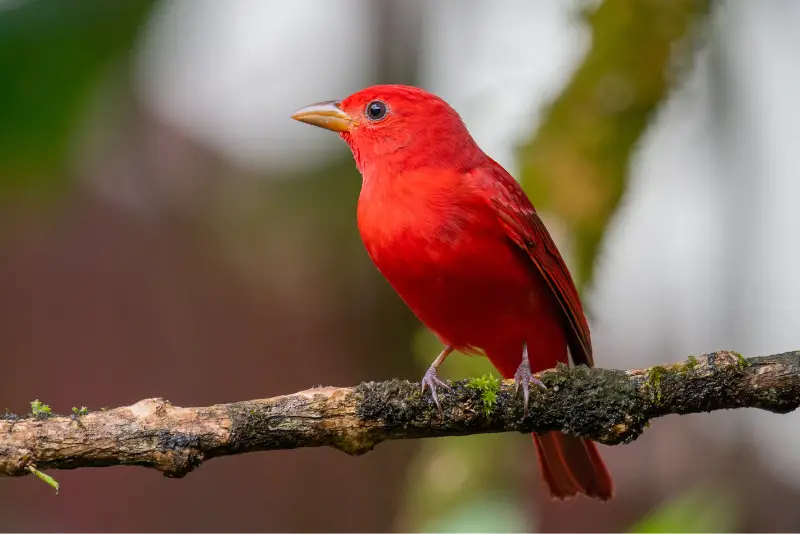
The Summer Tanager is a beautiful and alluring songbird with a peaked (as opposed to rounded) crown.
Adult male Summer Tanagers are entirely bright red, although they have slightly darker feathers on their wings.
It can be hard to observe Summer Tanagers, since they like to forage high in the treetops of deciduous and mixed forests, where they feed on insects, including bees and wasps.
In contrast to males, females and immature are more inconspicuous, and look more like buff yellow Arizona birds, although they sometimes have a few patches of pale red.
The Summer Tanager is a summer visitor and breeding species in Arizona, and can be seen here from May through August.
It is a strict migratory bird and spends the rest of its year in Mexico and Central America
Vermilion Flycatcher
Scientific name: Pyrocephalus obscurus
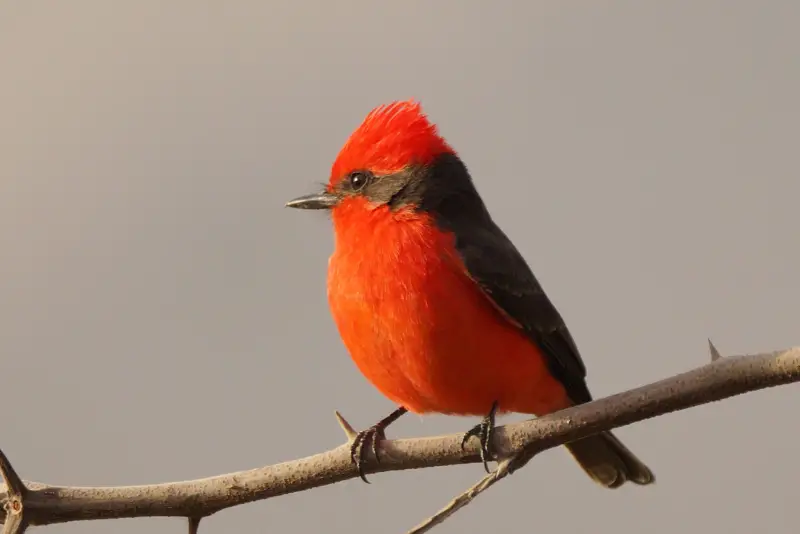
The Vermilion Flycatcher is one of the most beautiful birds that can be seen in Arizona, and is also found in the arid landscapes of the Sonoran Desert.
Adult males have a scarlet red underside, throat, and crown, while the rest of their body is dark brown.
Females and immature birds, on the other hand, are grayish brown on top, and pale underparts.
It is a strict migratory bird, with most Vermilion Flycatchers migrating to Central America to spend the winter, with only a handful of individuals remaining in North America during the cold season.
A great thing about this bird is that it isn’t very shy towards, and usually can be easily observed on exposed perches.
The preferred habitat of the Vermillion Flycatcher is open woodland and parks in areas close to water.
Pyrrhuloxia
Scientific name: Cardinalis sinuatus
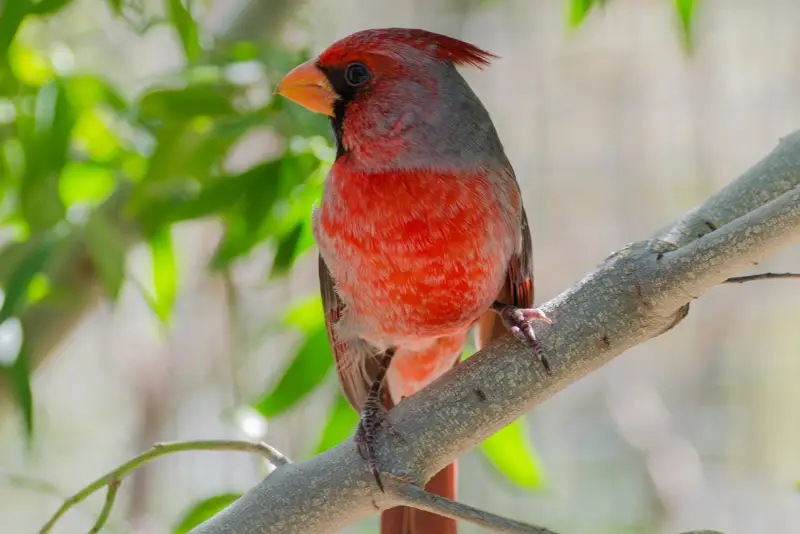
The Pyrrhuloxia is closely related to the Northern Cardinal, and can be viewed as its desert counterpart, which explains how it got the nickname “desert cardinal.”
Adult males are dark gray on their back, which contrasts with their bright red mask, crest, tail, and chest.
Females have more muted gray colors, except for pink plumage on their chest and belly.
The Pyrrhuloxia is a year-round resident in arid zones of Arizona, and is fiercely territorial during the breeding season.
During the winter months, it becomes more social and forms flocks that rove around together and sometimes show up at bird feeders.
Hepatic Tanager
Scientific name: Piranga flava

The Hepatic Tanager is a brightly colored songbird that resembles the Summer Tanager.
Adult males are mostly red, with gray undertones behind their eyes and on their back, and this gray coloration distinguishes them from males of the Summer Tanager.
Females, immature males, and juveniles, on the other hand, are more yellow with a grayish color on their ear coverts and back.
If you’re lucky, you might be able to glimpse them in southern Arizona from May through August. They spend the remainder of the year in Mexico or Central America.
And although these birds are not particularly shy, their colors mix in so perfectly with the foliage that they can be difficult to spot.
Western Tanager
Scientific name: Piranga ludoviciana
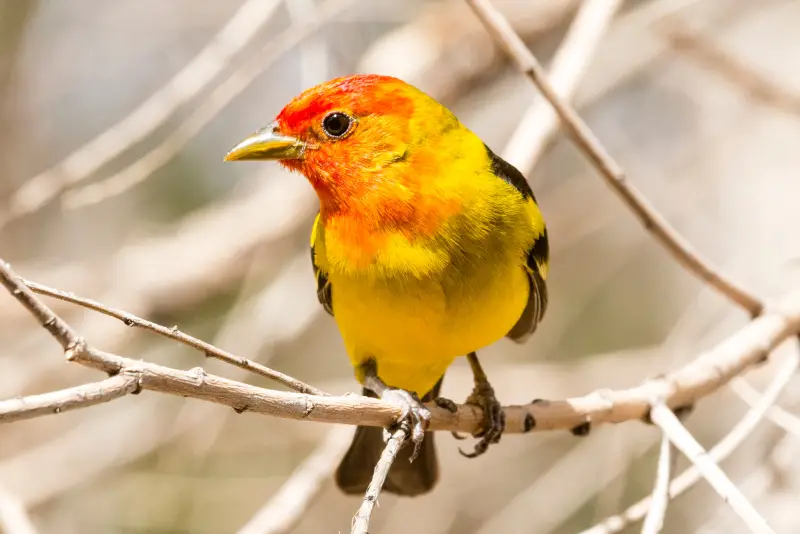
With its brilliant hues, male Western Tanagers are difficult to overlook.
Adult males have a black back, tail, and wings in the summer, with two yellow and white wingbars. Their bodies are yellow, while their head and throat are orange-red.
Females and juvenile birds have a similar appearance, but the yellow is duller and the red color is almost absent, with the exception of a speck near the base of the beak.
The Western Tanager may be seen in northern Arizona during the breeding season from May to August. These exotically colored birds spend the remainder of the year in Central America.
Cassin’s Finch
Scientific name: Haemorhous cassinii
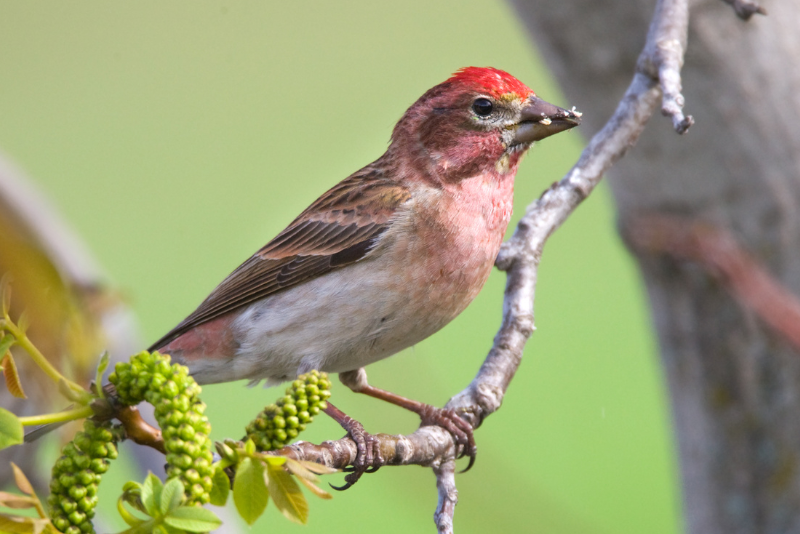
The Cassin’s Finch looks a lot like the Purple Finch, but is mostly found at higher altitudes than the latter.
Adult males have a raspberry red crown, chest, throat, and rump. Their neck and back are streaked brown, and their wings are somewhat darker with two pink wingbars and pale margins.
Adult females and juveniles lack the reddish color and instead are brown with dark streaks on top and slightly darker wings with two pale wingbars.
The Cassin’s Finch prefers coniferous forests and can be seen all year in the mountainous habitat of northern Arizona.
Outside of the breeding season, it forms flocks and sometimes visits lower elevations and more southern latitudes, especially in cold winters.
Painted Redstart
Scientific name: Myioborus pictus
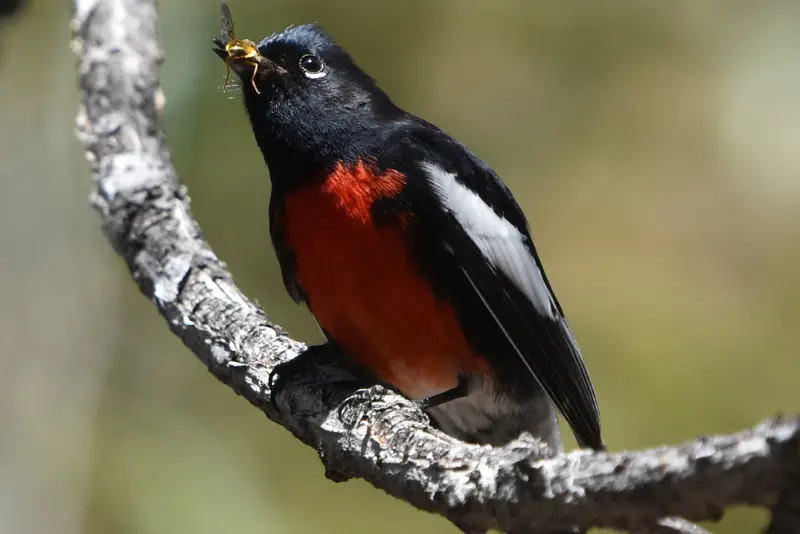
The Painted Redstart is a gorgeous wood warbler with a striking combination of red, black, and white plumage.
Adult males are predominantly black, contrasting with a bright red belly, white patches on the wings, white tail feathers, and a small white patch under the eye.
Adult females and young birds resemble males, but their belly is gray instead of red.
These colorful red birds can be seen in southeastern Arizona during the breeding season from March through September.
After the breeding season, the Painted Redstart migrates to Central America, where it spends the winter.
Painted Bunting
Scientific name: Passerina ciris
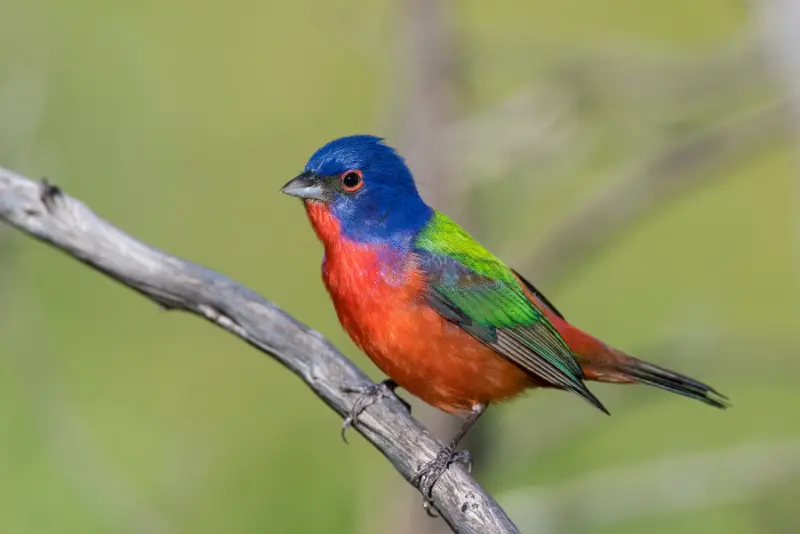
The Painted Bunting is a beautiful small songbird with a very colorful plumage.
Adult males have a bright red chest, throat, belly, and rump, contrasting with a dark blue hood. Their backs and the wings are yellowish green.
Females and immature birds are pale green on top, with buff yellow underparts.
During the months of May through September, the Painted Bunting may be seen breeding in the southeastern part of the state.
It is a migratory bird, with most individuals wintering in Central America, except for a few birds that spend the winter in southern Florida.
The secretive nature of the Painted Bunting makes it hard to observe, notwithstanding the bright colors of the male.
Its preferred habitat are clearings and margins of dense forests in areas close to water.
Similar to other buntings, this red and blue-colored bird feeds mostly on seeds, except for the breeding season, when insects form an important part of its diet.
Purple Finch
Scientific name: Haemorhous purpureus

The Purple Finch is a little songbird with a compact body, a conical beak, and a head that is disproportionately larger than its body.
The heads and breasts of adult males are a deep shade of raspberry red, while the backs of their bodies are streaked with brown and red. The flanks are cream colored with pink streaks.
Birds from the eastern part of the range have a white belly, whereas birds from the western part of the range have a gray belly. Purple Finches in Arizona have a gray belly.
The upperparts of females and immature birds are streaked with a grayish brown, while the underparts are a light cream color with brown streaks.
During the months of May through August, the Purple Finch is found breeding in northern parts of North America, and does not occur in Arizona.
During the winter, however, these birds migrate south and spend the cold months in the eastern United States. At this time they can be seen all over Arizona.
Red Crossbill
Scientific name: Loxia curvirostra
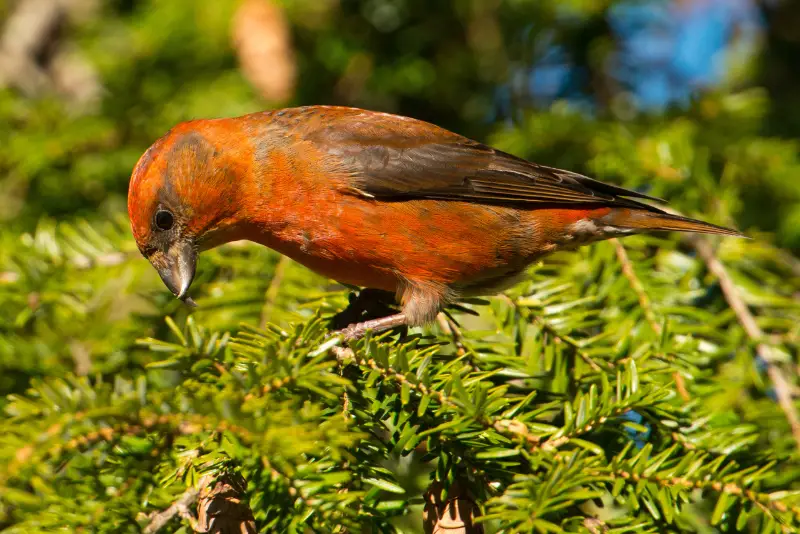
These birds get their name from their distinctive bills, which resemble a bent pair of scissors with their points crossed.
Adult males of this red bird have a bright red head, underside, and rump, while their wings and back are dark brown
Females and immature Red Crossbills are more inconspicuous, and are olive-colored with reddish streaks on their flanks and belly.
Red crossbills are able to harvest seeds from pine cones by cutting through the scales of the cones with their crossbill.
They will use their feet to keep the cones pinned down while they use their tongues to pick the seeds out of the cones and then eat them.
These red birds breed in Canada and northern parts of the USA, and only show up as scarce winter visitors in Arizona.
The breeding season of these crossbills is timed to coincide with ripening of pine or spruce cones, and can sometimes start as early as February.
Pine Grosbeak
Scientific name: Pinicola enucleator

The Pine Grosbeak is a red songbird with a short and stubby bill.
The adult males are red with varying amounts of gray on their sides and bellies. The tail and the wings are dark with two white wing bars.
Females are more drab, and have a more brownish yellow coloration compared to the males.
This red bird breeds in the mountainous regions of Arizona, where it is a year-round resident.
During the cold season, there is an influx of northern Pine Grosbeaks that spend the winter in the Grand Canyon state.
What Arizona birds are black and red?
There are five types of black and red birds in Arizona:
- Summer Tanager
- Vermilion Flycatcher
- Painted Redstart
- Northern Cardinal
- Red-winged Blackbird
Red-winged Blackbirds are the most common red and black birds found in Arizona. Males are almost entirely black, but also have a patch of bright red on their shoulders.
In contrast, male Northern Cardinals are almost entirely red, except for a black face.
What are small red birds in Arizona?
Small red-colored birds in Arizona are most often House Finches, which are very common statewide. Males can be readily identified by their reddish head, upper chest, and back
However, during the winter you can also encounter other small birds in Arizona that are red: the Purple Finch and the Cassin’s Finch. Both of these are winter visitors in Arizona, while the latter is also a breeding bird in the northernmost parts of the state.
How to attract birds to your yard in Arizona
The top 5 things you can do to attract red birds to your yard are as follows:
- Set up a feeder with sunflower seeds or a seed mix
- Set up a bird bath
- Plant shrubs to provide nesting opportunities
- Plant native fruiting plants
- In order to attract fruit-eating birds, offer apples or berries at your feeder
Observing birds at a bird feeder can be one of the most fun ways to practice bird watching from the comfort of your own home.
Final remarks
This concludes our article on the types of red songbirds found in Arizona.
If you’ve spotted one of these red birds while bird watching in your backyard, hopefully this ID guide will help you identify it quickly and easily.
And if you enjoyed this article, check out our guide to the large birds of Arizona.
